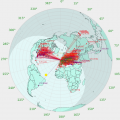The KiwiSDR 2 online store is open for orders! Please visit kiwisdr.nz
G8JNJ
About
- Username
- G8JNJ
- Joined
- Visits
- 3,313
- Last Active
- Roles
- Member
- Points
- 400
Reactions
-
SAQ 17.2KHz - 30th June 2019
Good signals into the UK this morning from SAQ on 17.2KHz using an historic alternator transmitter
https://alexander.n.se/?lang=en
15dB above the noise floor into Farnham WEB SDR http://farnham-sdr.com/ in SE UK
12dB above the noise floor into Kernow KiWI WEB SDR http://kernow.hopto.org:8073/ at Goonhilly Earth Station in Cornwall SW tip of UK (despite a very high noise floor)
Unfortunately too much switched mode power supply noise on my SWUK KiWi SDR http://southwest.ddns.net:8073/ which masked the SAQ signal.
Another transmission due later today at 13.30 (11.30 UTC) the alternator starts and at 14.00 (12.00 UTC) will be broadcasting a message
Martin G8JNJ (Admin for Farnham / Kernow and SWUKSDR) -
Aricebo - 5125KHz
I just realised that I got the project reference incorrect, as I'd worked out the wrong time from the schedule.
So the final session is now up and running until I estimate 18:00 UTC 14th June 2019
I can now hear the carrier being swept on the Anasco, Puerto Rico WEB SDR http://kp4ca.ddns.net:8073/ but not on mine yet.
They are using the dish.
Simulation and modeling results show that both arrays have
VSWRs less than 2:1 over a 100 kHz bandwidth no matter what the
state of the other passive arrays feed is (shorted, open, or terminated).
The gain at 5.1 MHz was 22.2 dBi. When fed with 600 kW of power,
this corresponds to an ERP of 99.6 MW. At 8.175 MHz, the gain was
25.5 dBi corresponding to an ERP of 212.9 MW. If the array is phased
to achieve circular polarization of either RHC or LHC, the crosspolarization from the opposite mode was above 27 dB for both
frequencies.
http://www.naic.edu/~astro/ao50/Arecibo_50th_Paper_Breakall_revised_Oct_23_2013.pdf
Here's the correct reference and summary of work.
General Category: Astronomy
Observation Category: Ionosphere
Total Time Requested: 24 Hours
Minimum Useful Time:
Proposal Title: Natural Analogs Via Ionospheric Experimental Research (NAVIER)
ABSTRACT:
This proposal is in collaboration with the planned NRL Probing Regions via Ionospheric Modi?cation (PRIM)
experiment, the goal is to study the physics of plasma irregularities created by the Arecibo HF Heater and their
impact on HF communications waveforms. MITRE will be providing an advanced HF transmitter and receiver pair
as well as standard HF radios to study the impact of arti?cial ?eld-aligned irregularities (AFRIs) on the HF signal
propagation. The locations of transmit and receive sites will be the Dominican Republic and St. Thomas
respectively. This a?ords a near-to-perpendicular signal propagation path with respect to the geomagnetic ?eld
lines over Arecibo, as shown in Figure 1. The outcomes of this experiment will include investigation of the physics
of the disturbed ionosphere, as well as a large-scale data collection and analysis on the impacts of heater AFRIs on
HFnear vertical incidence skywave (NVIS) propagation.
Name Institution E-mail Phone Student
Edlyn V. Levine MITRECorporation evlevine@... 412-7265480 no
Remote Observing Request
X Observer will travel to AO
Remote Observing
In Absentia (instructions to oper-
ator)
Instrument Setup
430 Xmit
Atmospheric Observation Instruments:
Tilt-Photometer Spectrophotometer Fabry-Perot Ionosonde Lidar
Description of Observer Equipment: MITRE will provide a Digisonde ionospheric sounder for 1
deployment near to the Arecibo facility. MITRE will appreciate the AO support to deploy the instrument
Special Equipment or setup: The ISR will be the primary instrument as well as our own
diagnostics. The other instruments are a backup.
RFI Considerations
Frequency Ranges Planned
2
Sweep rate is 100mS occupying 26KHz.
Scope and Spectrum plots attached but I was only able to sample in a 10KHz BW.

Regards,
Martin - G8JNJ -
RF Pro-1B Issue Developing
-
Aricebo - 5125KHz
Aricebo was operating again last night, putting a very strong carrier (but with weak 120Hz sidebands) into the UK on 5125KHz.
It was a LOTstronger into KP4CA http://kp4ca.ddns.net:8073/ in Anasco, Puerto Rico ?as you would expect :-)
No sweeps were observed this time, however it looks like there may be more opportunities over the next week or so.
It's a pity that there is so little up to date information about this on the web, but I have found an operational schedule.
Look up reference T1193 running up to and on the 15th of June and again commencing Sat 29th of June
http://naic.edu/vscience/schedule/scedfra2.htm
Note that AST is equal to UTC -4
LST (Local Sidereal Time) could be anything :-)
Regards,
Martin - G8JNJ -
QRM: Radio China International - From Albania - OV +++
Hi Giulio,
Adding a series tuned notch filter across the KiWi RF input will help reduce the problems on 7345KHz.
These values give the bets compromise between notch depth and attenuation on the adjacent 40m amateur band.
For this simulation I have used an inductor with a Q of 50. But if you can use a better inductor, it will provide a deeper and narrower notch.
31 turns wound on a T50-2 iron powder core would be a good starting point, but you would have to add or remove turns in order to tune the notch to the exact frequency.
It will attenuate signals on 40m to a certain extent, so the signal levels will drop slightly, however as the natural noise floor is usually the limiting factor on the lower frequency bands, I don't think it will harm the Signal to Noise ratio.
As a test you could run the WSPR decoder with and without the notch in circuit, and compare the average S/N before and after, but always compare reports of the same transmitting stations, don't compare different stations with each other.
The other interference is something local to you, but sort out the 7MHz overload before investigating the other problems.
Regards,
Martin - G8JNJ




